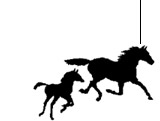|
Economic Value of Horses
Where is a horse worth more?
Since industries and even governments are largely profit-oriented, it is fitting to explore financial considerations surrounding the slaughter of horses versus the husbandry of live horses for sport or companionship. Here's an overview of just a few examples.
Who profits from horse slaughter?

A butchered horse yields meat that is shipped to foreign countries, resulting in revenue that fluctuates with current market trends. Live horses are also sent from Canada to Japan and the U.S. for slaughter. In addition to supplying abattoirs with profits and providing some high-turnover, high-risk jobs, horse slaughter helps to support the following sectors of the business world:
- Certain breeders, auction marts, feedlots, and transporters
- Manufacturers, distributors and merchants for transport trucks and trailers
- Manufacturers, distributors and merchants for equipment used in slaughterhouses
- Manufacturers, distributors, and merchants for fencing materials, feed and water troughs
- Fuel companies
- Airline companies that ship horses overseas
- Hay farmers, grain growers, and merchants
- Certain veterinarians
Who profits from the lives of horses destined for recreational markets?
- Certain breeders, private horse owners, auction marts and transporters
- Manufacturers, distributors and merchants for horse trailers
- Fuel companies (we believe that more fuel would be consumed through the widespread and frequent hauling activities of private horse keepers, as opposed to gas consumption by large transport trucks that move many head of horses in one trip to a feedlot, auction, or slaughterhouse)
- Hay and straw farmers, grain growers and merchants
- Thousands of farriers
- Thousands of large animal veterinarians (diagnostics, treatments, hospitalizations, surgeries, transport fees) and the people they employ
- Medical supply companies, distributors, and merchants (X-ray machines, centrifuges, etc.)
- Laboratories (blood, tissue, and wound samples, etc.)
- Equine therapists and acupuncturists
- Pharmaceutical companies (dewormers, immunizations, liniments, medications)
- Horse supply companies (manufacturers, distributors, and merchants for blankets, tack, fly spray, ointments, fly masks, linament for rubdowns, bandages, wraps, grooming supplies, buckets, feeders, hay nets, etc.)
- Manufacturers, distributors, and merchants for fencing and shelter materials
- Boarding stables
- Horse trainers
- Manufacturers, distributors, and merchants for equestrian show jumps & training equipment manufacturers
- Bed and Bale (B&B) businesses
- Trail riding camps
- Trail riding outfitters
- The sport horse/eventing industry (upkeep, training, events and entry fees, special bits and bridles, plaiting of manes and tails, advertising, media, food venues)
- Creators, publishers and merchants involved in horse books, calendars, magazines, posters, toy horses
- Artists, sculptors, photographers, cartoonists, framers, galleries
In addition, huge show jumping events such as those held at Spruce Meadows hold widespread public appeal and attract international competitors. The facility employs over 70 full-time people, and its record attendance on a Sunday in 2002 was over 57,000. More than $5 million in prize money has been awarded toward this horse event by businesses and donors. Visit: sprucemeadows.com.
Further, if they cannot compete, hundreds of horses are employed as outriders at races and competitions throughout Canada and the U.S.
Let us also remember the RCMP (Royal Canadian Mounted Police), whose Musical Ride is a tribute not only to our police force, but to the horses who have served this country well.
A Thriving Canadian Industry
The example below provides data from just one region in Canada--York, Ontario--and was derived from a report written by York Region's Economic Development Committee in February 2000:
"The horse industry in York Region provides a significant contribution to the economy. With about $400 million in capital investment, the industry contributes $40 million in revenue to local farms and stables, $37 million in direct expenditures to local feed, bedding, product and service providers, and provides more than 6,000 full-time jobs within the Region. In addition, the industry brings approximately 100,000 people to the Region each year to participate in riding and other horse-related activities."
link
Are Canadian horses worth more alive or dead?
Please write to us with your comments at our email address.
"Help us lead Canada's horses away from barbarism . .
and into the protected pastures of a civilized
nation."
|


